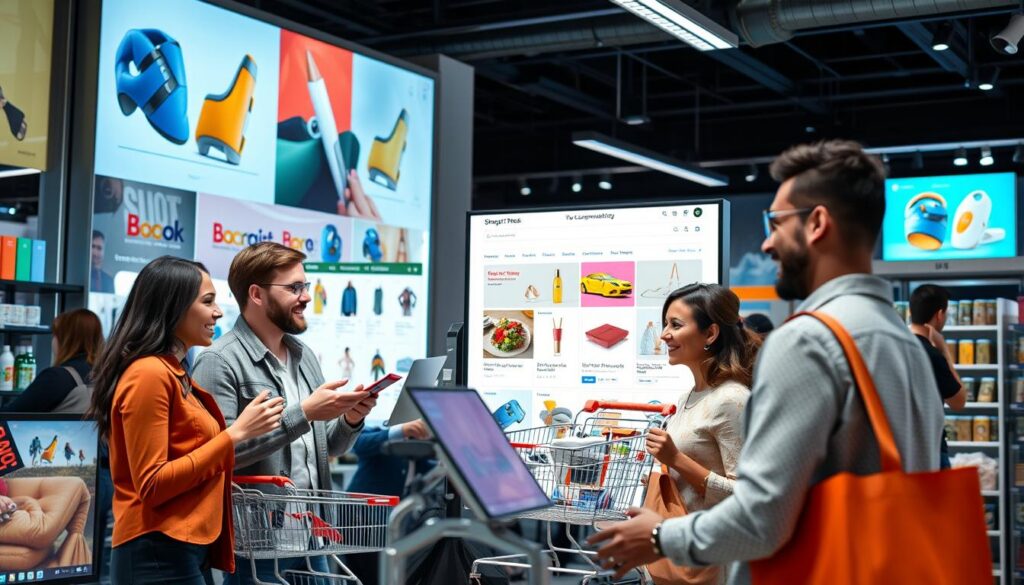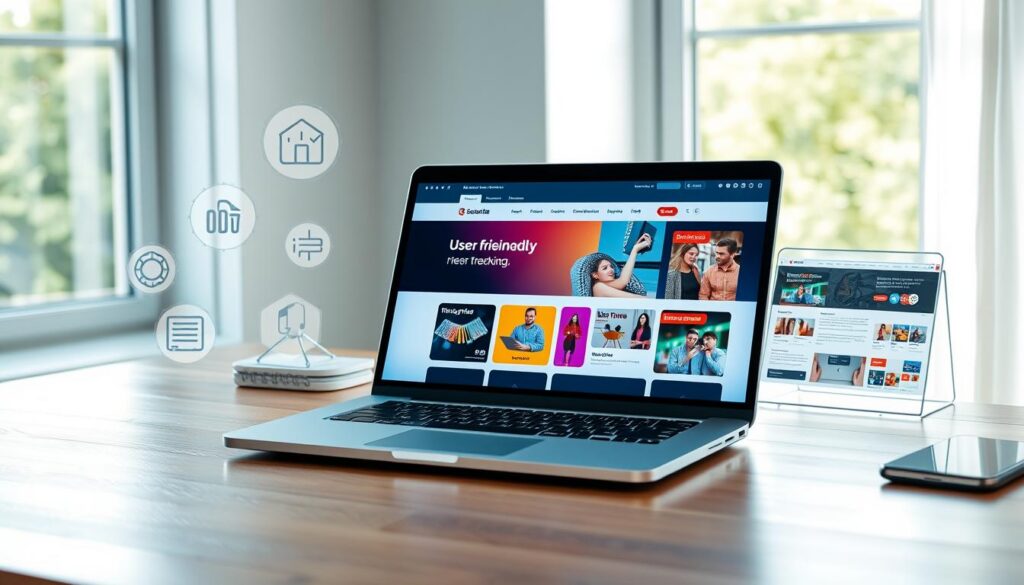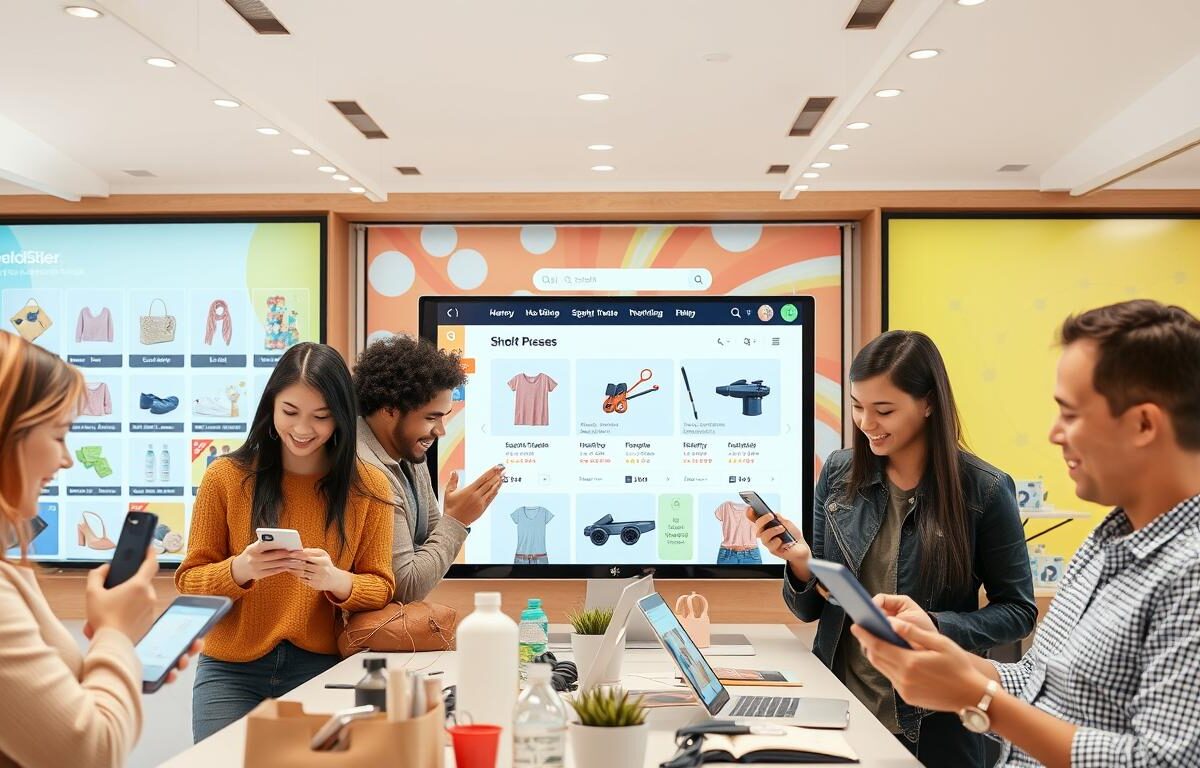In the digital marketplace, being a step ahead is crucial. The enhance online customer experiences play a big role. Businesses that make this a priority often see great benefits. This is because quick and easy shopping is now expected by everyone.
Customers today want websites that load quickly and are easy to use on any device. They also look for clear, high-quality pictures of products. Paying attention to these points is key to improve customer satisfaction and increase customer engagement.
But there’s more to it than just looks and speed. Adding customer reviews, using the right colors, keeping the stock updated, and making communication easy can build trust. Adding live chat, making checkout simple, and offering things like free shipping can take the enhance online customer experiences even further. It’s about making both the practical and emotional parts of shopping online better. This leads to customers being happier with the brand and interacting more.
E-commerce businesses should understand the value of investing in customer experience (CX). The Temkin Group found such investment could bring a huge revenue increase over three years. Given that over half of web visits are from mobiles, it shows the importance of a good experience on any device. American Express even found that excellent service could lead people to spend up to 17% more. This goes to show the real value of amazing CX.
Key Takeaways
- Seamless user experience is essential to remain competitive in the online marketplace.
- Fast loading times and user-friendly design directly contribute to improved customer satisfaction.
- Personalization enhances the shopping journey, as 80% of consumers are more likely to purchase from a brand that offers tailored experiences.
- Focusing on omnichannel approaches is crucial due to over 50% of web traffic now being mobile.
- Investing in customer experience strategies can significantly reduce operational costs and decrease customer churn.
- Consistently delivering high-caliber customer service can command higher price points and foster brand loyalty.
- Continuous monitoring and improvement of customer experience are essential for retaining and acquiring customers while distinguishing a brand from its competitors.
Understanding the Importance of Customer Experience Online
Today’s businesses must adapt to the digital era. They need to improve how they connect with customers online. Making online customer interactions better is crucial for loyalty and growth.
Definition of Online Customer Experience
The online customer experience covers a company’s digital aspects. This includes its website’s ease of use and quality of content. Good strategies make the customer’s journey simple and enjoyable, increasing satisfaction and loyalty.
Key Statistics on E-Commerce Experience
Statistics show the importance of enhancing the e-commerce experience. For example, 72% of consumers say their buying is affected by economic and social changes. Using tools like Google Analytics helps businesses understand and improve how users interact with their sites.
Impact on Brand Loyalty and Sales
Investing in a great digital experience boosts brand loyalty and sales. Even a small delay in loading a page can lose sales and lower satisfaction. Personalizing the user experience with data analytics makes users more loyal and increases sales.
Effective methods to improve the online experience include:
- Streamlining the checkout process to reduce cart abandonment.
- Using live chat and chatbots for quick help.
- Ensuring websites work well on all devices for a better mobile experience.
These strategies help in gaining new customers and support business growth. They prepare businesses to succeed in the competitive online market.
| Challenge | Percentage of Respondents |
|---|---|
| Understanding customer needs | 22% |
| Adapting to demanding expectations | 21% |
| Scaling customer experience operations | 21% |
| Preventing churn and boosting retention | 20% |
| Effectiveness of AI chatbots | 15% |

Identifying Elements of a Successful Online Experience
Improving a website’s usability and enhancing user experience design is key. It requires focusing on key factors that affect how customers interact online. These elements, when recognized and applied, greatly enhance digital engagement.
Website Usability Features
Optimizing website usability is essential for a better online customer experience. This includes fast load times, easy navigation, and effective site search capabilities. These factors reduce user frustration and prevent them from leaving the site. For example, businesses should know customers want websites to load in less than two seconds. A one-second delay can cause a 7% decrease in conversions. Making technical improvements is crucial to enhance website usability.
Importance of Mobile Optimization
More and more users access sites via mobile devices. Thus, mobile optimization is a critical part of user experience design. Responsive designs make sure sites work well on any device, keeping users engaged. Studies show 40% of people leave a site if it takes over three seconds to load on mobile. This highlights the need for quick, adaptable sites for mobile users.
Personalization Techniques
Personalized interactions greatly improve user experience design. About 88% of online shoppers prefer brands that provide tailored experiences. Offering content and recommendations based on user behavior enhances engagement and increases sales. Firms using these strategies often see a sales increase of up to 15%. This shows the importance of personalization in digital marketing.

Creating a successful online experience means offering intuitive, seamless, and personalized interactions to every visitor. By focusing on usability, mobile optimization, and personalization, companies can greatly improve user experience. This leads to more customer retention and loyalty. Brands emphasizing these customer interaction aspects will stand out and grow sustainably in the evolving digital world.
Strategies to Enhance Online Customer Experience
To genuinely enhance online customer experience, we need focused strategies. Responsive design, data-driven insights, and engaging content are key. These tactics boost customer satisfaction and help businesses grow. Let’s explore how these strategies improve the online customer journey.
Implementing Responsive Design
Adapting to the increase of mobile users is crucial. Responsive design offers seamless navigation on any device. This boosts user engagement and satisfaction. It also helps with better conversion rates and customer retention.
Utilizing Data Analytics for Insights
Businesses use data analytics to understand customer behaviors and preferences. This knowledge refines marketing strategies and personalization efforts. It leads to more effective targeting and enhanced customer experiences.
Engaging Content Creation
Crafting content that resonates with your audience is vital. It grabs their attention and guides them through the purchasing journey. Good content informs, entertains, and convinces, building a stronger connection with the brand.
Improving online customer experience impacts business metrics significantly. Combining technology with customer-focused practices is essential for success.
| Enhancement Strategy | Impact on Business Metrics | Percentage Increase |
|---|---|---|
| Improved Customer Experience | Sales Revenue | Up to 7% |
| Enhanced Cross-Selling | Cross-sell Rates | Up to 25% |
| Positive Brand Loyalty | Shareholder Return | Up to 10% |
| Loyalty Program Inclusion | Repurchase Influence | 83% |
| Community Onboarding | Brand Trust and Engagement | Significant Increase |
These statistics show the big benefits of improving online customer experience. From responsive design to engaging content, each aspect is crucial. They’re key for businesses wanting to do well in digital markets.
Leveraging Technology for Customer Experience
Technology has changed customer service in big ways. It makes interactions better and satisfies customers more. Using new tech makes online talks optimize online customer interactions and makes the user experience better. This leads to happy and satisfied customers.
AI and Chatbots in Customer Interaction
AI chatbots have changed customer service a lot. They give quick answers to questions, making customer service better. With stats showing their success, their importance is clear. Companies using chatbots like Intercom and Drift see better customer service. They handle queries all day, cutting wait times and increasing happiness.
Virtual Reality and Augmented Reality Applications
VR and AR let customers try products in a new way. They solve a big problem of online shopping: not experiencing products. Customers can see products in their space or on them.
Tools for Real-Time Feedback
Tools for real-time feedback are very important. They help understand what customers think. Tools like Salesforce and HubSpot gather insights, leading to better customer talks. This link talks about it. Using these tools makes relationships with customers better and helps businesses make smart choices. This keeps customers coming back.
| Technology Type | Primary Benefit | Example Platforms |
|---|---|---|
| AI Chatbots | 24/7 Customer Query Handling | Intercom, Drift |
| Virtual Reality (VR) | Immersive Product Trials | Meta Quest, HTC Vive |
| Customer Feedback Tools | Real-Time Feedback Analysis | Salesforce, HubSpot |
Using these technologies helps businesses meet and exceed expectations. It provides a solid base for growth and satisfaction. By adding smart solutions, companies create an engaging experience. This helps them stand out in a competitive market.
Measuring and Improving Customer Experience Over Time
In today’s digital world, companies need to keep up with changing customer needs and tech advancements. Salesforce data shows 47% of customers will pay more for better service. So, it’s crucial for businesses to find effective ways to measure and boost online customer experiences.
Key Performance Indicators (KPIs) to Track
It’s critical to measure how well customer experience efforts are doing. Keeping an eye on KPIs like website speed, conversion rates, and Net Promoter Score® helps gauge customer interaction. A Coveo survey found that 33% of UK and US adults would stop using a brand after two bad experiences. This shows the importance of quickly using data to improve. Tools like Zendesk help businesses customize dashboards to monitor these KPIs and adjust strategies on the fly.
Customer Feedback Mechanisms
Listening to customers is key to getting better. Twilio’s data says only 15% of consumers think brands are good at personalizing. Effective feedback channels are essential. Surveys, reviews, and direct talks can all provide insights. A Deloitte study shows that top-notch personalization can raise satisfaction, conversions, and engagement.
Continuous Improvement Practices
Customer experience efforts should always be evolving. It’s crucial for staying ahead. A study by Five9 and Shep Hyken found 86% of US consumers would switch brands for better service. Combining customer feedback with ongoing analysis promotes continuous improvement. With 34% of marketers using AI for personalization, according to Funnel, the focus on tailored and dynamic interactions is growing. This can significantly boost loyalty and the value customers bring over time.
FAQ
How can e-commerce businesses enhance online customer experiences?
E-commerce businesses can boost online experiences by making sure their sites load fast. They should work well on all devices. High-quality photos and clear content help too.
Adding customer reviews, an easy-to-use design, and simple ways to get in touch are key. These features really help make customers happy.
What is the definition of the online customer experience?
The online customer experience is all about how customers interact with a brand’s digital space. It starts when they first visit the website and goes all the way to after they buy something. It covers everything from how easy the site is to use, to how engaged and personalised the service feels.
What impact does online customer experience have on brand loyalty and sales?
A great online experience can make customers stay loyal and buy more. Happy customers often come back and tell others about the brand. This can mean more sales and long-term success for the brand.
What are critical website usability features that contribute to a successful online experience?
Important features for a good website include fast loading, easy navigation, and a good search function. These things stop users from getting frustrated and leaving the site. This leads to a better experience for everyone.
Why is the mobile optimization of a website crucial?
Mobile optimization is key because lots of people surf the web on their phones. An optimized site adjusts its content to fit different screen sizes well. This keeps mobile users happy and provides a good experience on any device.
How do personalization techniques enhance the online shopping experience?
Personalization, like showing content and suggestions based on what users did before, makes shopping feel special for each person. This can make users more interested and boost sales.
What are some strategies to further enhance the online customer experience?
To make the online experience even better, businesses can use responsive design and data analytics. Interesting content that speaks to their audience helps too. Making the checkout smoother and offering perks like free shipping are wise moves.
How are AI and chatbots transforming customer interaction online?
AI and chatbots change how customers get help by offering instant help. They can answer common questions fast and handle many customer service tasks. This improves support and the overall online experience.
What role does real-time feedback play in online shopping?
Real-time feedback, like reviews and live chats, helps build trust. It lets customers see what others think of a product before they buy. This can greatly sway someone’s decision to make a purchase.
Which key performance indicators (KPIs) are crucial to track for improving online customer experience over time?
Key KPIs to watch include how long the site takes to load, how many visitors buy something, bounce rates, and how often people leave their shopping carts. Tracking these helps businesses see where they can get better and make the user experience smoother.
How can companies collect customer feedback effectively online?
Companies can gather feedback through online reviews, surveys, and talking directly via email or social media. Making it easy for customers to share their thoughts helps businesses get useful feedback to improve their services.
What are the best practices for continuous improvement of the online customer experience?
To keep getting better, using customer data and feedback to understand what users like is important. Trying out new website features and keeping up with the latest in user experience design are good practices. This keeps the digital experience fresh and appealing.



